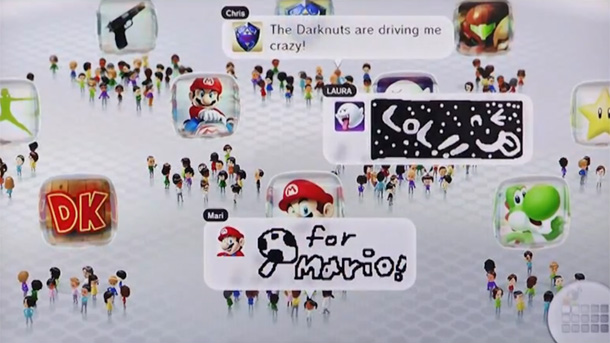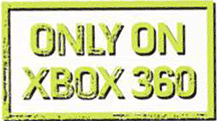When you put all the boxarts like that I really think the Wii U one stands out. I actually kind of like it now. (still not completely sold).
Yes. This is going to be a long post, but I am going to explain why I think Nintendo has made an extremely smart choice, both in terms of their design and how it relates to the consumer + competition.
Opinions on Nintendo's Wii U case design choices:
One thing, from a sales perspective, is to consider the general consumer and what catches their attention.
I know tons of people in the other thread have been saying regarding boxart "it would look so much better in black" or something along those lines
But let's consider some of the design elements:
Blue box, general "curve" in blue at the top, highlighted in yellow at the bottom
Why so significant? Why choose blue? In the console space, black would not be ideal. One reason for this is PS3 labels are black; the PS3 is a very popular console and it doesn't stand out immediately. One very important thing in terms of aesthetic is how quickly and "eye catching" something is. Going black is too common, and already used by the PS3. Sure the argument could be made "but look at the solid black, all black case, etc...PS3 has neither of those"...which is true, but black doesn't stand out as well nor universally as blue. Plus Nintendo is making the Wii U to have two primary console colours; White and Black. The blue goes better against both of those colours. It is important on a marketing level, but more so on a design level.
On the other hand, one area Microsoft really did well with was differentiating entire cases with a unique colour. The Green stands out immediately, and even the slightly different hue (and lighter tone & borders on the front) differentiated it enough between generations (XB1 vs 360 cases)
Nintendo also experienced this with the Wii on 3 different levels, 2 of them significant. First, back in 2006, they brought in white DVD cases which matched the tone they were going for. It was slick, and very simple. Those cases were excellent in both highlighting the new design philosophy from Nintendo at the time, meshed nicely with their "for everyone" console, and added to the "new Nintendo" sleek image. Amongst the general public, Nintendo has greatly improved their image and branding just through the Wii's marketing and design choices alone. It literally is their best image they've had since the original NES, which was predominantly marketed for children.
The second level Nintendo found success with standing out cases was with New Super Mario Bros Wii (which they then transitioned to Mario DS games having something similar, other games with coloured cases such as the recent Olympics Sonic/Mario title and in Japan the black cases for their version of "M" rated games). The Red case was huge in isolating the title as a special, classic Mario title which worked on so many levels for the consumer. It was a brilliant design move, and worked amazing on a marketing level as well. I could write an essay on that alone.
Anyways, the Wii cases are white and also very popular. Yet, Nintendo learned with the confusion form DS & 3DS, they need to do more to differentiate the cases. The 3DS cases caused much confusion for customers, even though they were slimmer and had the system branding on the opposite side of the case, its pretty obvious as to how confusion could have been created for people who are not extremely game savvy (which amounts to most of the people who actually buy the systems despite what GAF's opinions would have one believe)
Now, one thing Nintendo's marketing and design teams would have asked is "how can we stand out from the console crowd, which includes Xbox 360 games (clear green cases with a "green & white" branding; secondary branding is purple with kinect which is popular in some markets), PS3 (black borders in clear cases; Sony does use blue a lot in their branding, especially with blu ray and the HD connection, Move, as well as in adverts), and Nintendo's own white Wii cases.
Console game are, after all, generally in the same vicinity in the electronics sections of general stores or video game sections of speciality stores.
So the blue case makes a lot of sense, along with the curved border at the top with the "Wii U branding" centred. The white font works very nice with the lighter blue hue, both of which are well associated with the very popular Wii branding yet look entirely different due to the blue cases. The entire case being blue stands out from the HD competition yet can link many tech savvy gamers with "blu ray" disks (many people on this site brought up the blu ray link, as an example of how that already has worked), and allows Nintendo to use a "friendly" colour (blue) which is one of the most naturally well liked colours by and large. In some marketing fields, blue is the translation of "confidence" so it could imply "confidence" in buying games.
Another thing is its different, and can apply as a pleasing hue in all major world markets, much like the effect of the white cases the Wii had.
Much of that could also apply to Vita cases, which are also blue, and the Vita marketing teams likely had similar discussions. Those reasons to go with certain colours are generally universal in general cases. However, Vita's blue branding won't quite interfere with Nintendo's blue Wii U branding for a few significant reasons:
A) it has not caught on and doesn't take up much shelf space, and likely won't share as much shelf space as the Wii U games will,
B) handhelds are not always side-by-side with consoles...they tend to be in neighbouring or opposing sections,
C) the physical dimensions of the cases are different as are the hues & subliminal design choices such as the yellow hue
Speaking of which, the yellow hue that everyone seems to be hating on is actually a brilliant design move when one thinks about it.
Much of of the art in marketing is taking advantage of the subconscious human mind via subliminal messaging. It can work just as effectively as something blatant.
Yellow works well against the blue colour Nintendo chose. They may choose to make yellow another branding colour (perhaps with the NFC capabilities?), and it is one current colour not used excessively by the competition nor Nintendo's other systems on the market (3DS is red, DS nor Wii have yellow branding in any major way), and the main thing is it stands out.
Again, the subliminal stuff is key with some design choices, and it is one thing that is already "linked" with the Wii U. It allows the blue box to stand out more than without the yellow hue. The curve, goes with the curvy design of this system.
People might not like it, but it gets the intended job done.
Make no mistake, an immense amount of work goes into design marketing and every tiny detail is scrutinized (sometimes in seemingly ridiculous detail) but it functions.
I think Nintendo did a great job here with the overall design. One always has to make a choice (i.e. "Do we choose to go with this, or with this? This or this?") and pick the lesser of two evils of the better of two choices, and it will never ever appeal to every single person, but as long as it get the job done, its a job well done.





















